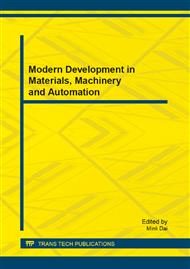[1]
S. Z. Zhang, W. M. Zhang, M. Li, S. Xue, J. Q. Wang, F. F. Lu, C. Yao, Subthalamic nucleus-deep brain stimulation for Parkinson disease after combined lesioning of the unilateral globus pallidus and ventralis intermedius, Chinese Journal of Minimally Invasive Neurosurgery, Vol. 16, no. 2(2011).
DOI: 10.1093/neuros/nyaa201
Google Scholar
[2]
D. X. Huang, Clinical experience of treatment Parkinson disease in brain stereotactic radiofrequency lesion, Journal of North China Coal Medical University, Vol. 11, no. 5(2009), pp.674-675.
Google Scholar
[3]
S. Santaniello, G. Fiengo, L. Glielmo, DBS feedback controlled tremor suppression in Parkinson's disease, in Proc. 17th IEEE International Conference on Control Applications (2008), pp.666-671.
DOI: 10.1109/cca.2008.4629659
Google Scholar
[4]
J. Wang, W. M. Zhang, Patient treatment and target choose of Parkinson's disease in deep brain stimulation, Chinese Journal of Nervous and Mental Diseases, Vol. 37, no. 6(2011), pp.379-382.
Google Scholar
[5]
A. ROSENFELD, Fuzzy digital topology, Information and Control, Vol. 40, no. 1(1979), pp.76-87.
Google Scholar
[6]
I. Bloch, Fuzzy connectivity and mathematical morphology, Pattern Recognition Letters, Vol. 14, no. 6 (1993), pp.483-488.
DOI: 10.1016/0167-8655(93)90028-c
Google Scholar
[7]
S. Dellepiane, Extraction of intensity connectedness for image processing, Pattern Recognition Letters, Vol. 16, no. 3 (1995), pp.313-324.
DOI: 10.1016/0167-8655(94)00088-k
Google Scholar
[8]
J. K. Udupa, S. Samarasekera, Fuzzy connectedness and object definition: theory, algorithms, and applications in image segmentation, Graphical Models and Image Processing, Vol. 58, no. 3 (1996), pp.246-261.
DOI: 10.1006/gmip.1996.0021
Google Scholar
[9]
J. K. Udupa, L. Wei, S. Samarasekera, Multiple sclerosis lesion quantification using fuzzy-connectedness principles, IEEE Trans. on Medical Imaging, Vol. 16, no. 5(1997), pp.598-609.
DOI: 10.1109/42.640750
Google Scholar
[10]
V. Harati, R. Khayati, A. Farzan, Fully automated tumor segmentation based on improved fuzzy connectedness algorithm in brain MR images, Biology and Medicine, Vol. 41(2011), pp.483-492.
DOI: 10.1016/j.compbiomed.2011.04.010
Google Scholar
[11]
Y. H. Liu, G. F. S. Chen, Z.P. Huang, MITK-based fuzzy connectedness on CT series image segmentation, Journal of Xiangnan University, Vol. 32, no. 2(2011), pp.38-40.
Google Scholar
[12]
A. R. Yang, C. X. Lin, H. Q. Li, A hybrid segmentation method using fuzzy connectedness and voronoi diagram classification, Computer Applications and Software, Vol. 28, no. 1(2011), pp.105-108.
Google Scholar
[13]
M. J. Mcauliffe, F. M. Lalonde, D. Mcgarry, W. Gandler, K. Csaky, B. L. Trus, Medical image processing, analysis & visualization in clinical research, in Proc. 14th IEEE Symposium on Computer-Based Medical Systems(2001), pp.381-386.
DOI: 10.1109/cbms.2001.941749
Google Scholar
[14]
Amol S. Pednekar, Ioannis A. Kakadiaris, Image segmentation based on fuzzy connectedness using dynamic weights. IEEE Transactions on Image Processing, Vol. 15, no. 6(2006), pp.1555-1562.
DOI: 10.1109/tip.2006.871165
Google Scholar


